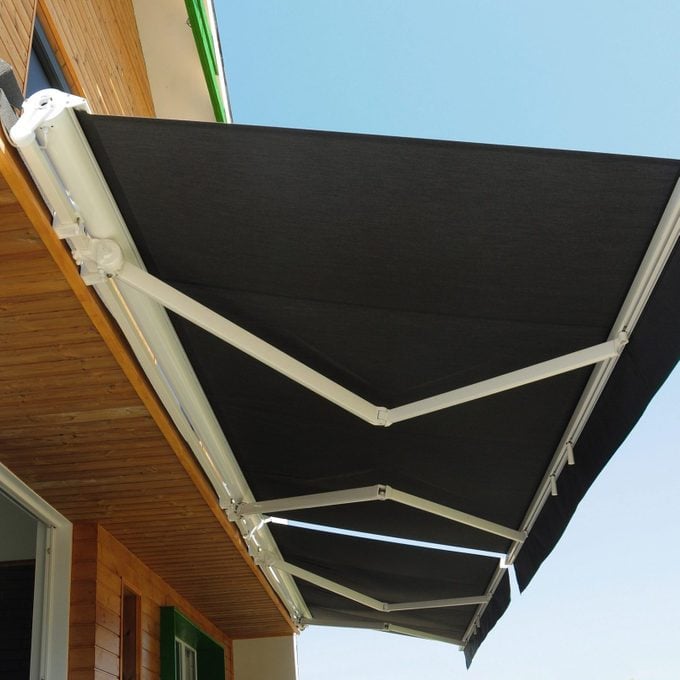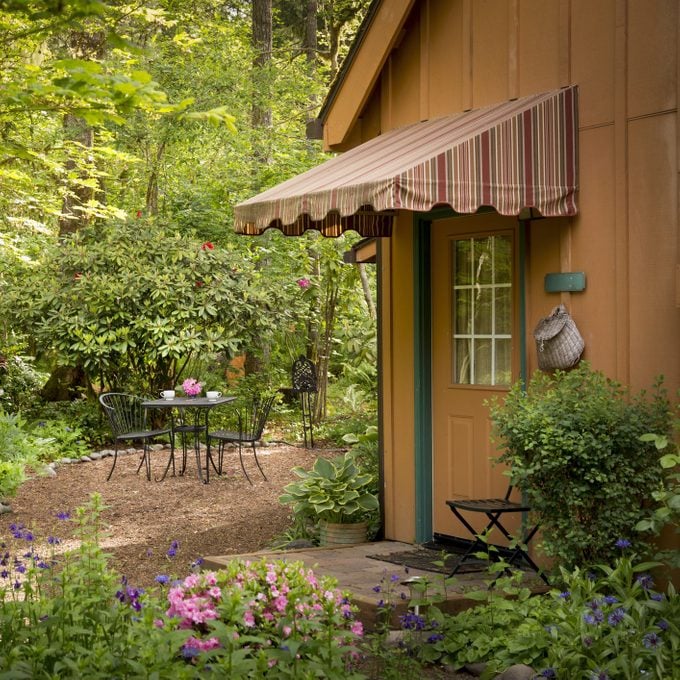You may not have given awnings much thought until you stood in the pouring rain trying to unlock your door, or baked in the sun on your new deck. For those times, an awning would be ideal. Here’s what you need to know if you’re considering awnings for your home.
What Is an Awning?
An awning is a roof-like cover that extends over a space to offer shade and shelter from rain, wind or snow. Awnings are often found over the windows and doors of homes and commercial buildings. Jim Kopf, vice president of Nashville Tent And Awning Co., says the best awnings provide predictable shade and protection from the elements.
With that in mind, awnings are available in various shapes, materials and sizes to accommodate all kinds of uses and styles. Regardless of the material used, awnings can be fixed or retractable.
Fixed awning
Most commercial buildings feature fixed awnings at their entrances and other outdoor spaces. These are usually made of aluminum or metal, making them more durable than fabric. These awnings are expensive because they can withstand storms and bear weight from water, snow or fallen tree limbs. They last for years with little to no maintenance.
 Lex20/Getty Images
Lex20/Getty Images
Retractable awning
Homeowners often opt for retractable awnings for their versatility. The technology has advanced significantly in recent years, making these awnings more affordable and customizable.
Retractable awnings save space because they’re attached overhead and can be stowed away in the event of high winds and heavy snow. Retractable awnings vary in price, depending on whether they are manual, motorized or remote-controlled.
Types of Awnings
While an awning primarily provides shade and shelter, there are still many variations. The type of awning you need depends on how and where you use it. If you’re designing the backyard dining space of your dreams and want to add a little shade and privacy, your needs are different from someone looking to deep delivered packages dry.
Here are four types of awnings for you to consider:
Patio awning
Patio awnings (AKA shade cloths or sails) are the most affordable and easily installed option, making it a popular solution for homeowners, Kopf says. This flat, thin awning, typically made of waterproof fabric, mounts to a wall and extends outward to provide shade and shelter. The best kinds dress up a patio or deck.
These are often made of cotton, canvas or polyester. However, some patio awnings allow water to pass through and are only meant to provide shade. These are perfect above pools or in places where the homeowner only needs to block sunlight for an hour or two a day.
Metal awning
Metal awnings offer long-term protection. They are usually made of aluminum because it’s affordable. However, there are many options that last for years with little maintenance. Plus, they can be painted to match your home.
Some of these awnings can be removed, but not all. “Often metal awnings are welded to the exterior of a home or business, which makes it much trickier than, say a patio awning, to remove,” Kopf says.
Freestanding awning
As its name suggests, a freestanding awning is not mounted to a wall. This allows for more customization for places like rooftop bars, pools or playgrounds.
Support beams secure the awning and it can be designed to fit the space. Many of these awnings are made of canvas to provide shelter from water and heat. They should, however, be removed in the winter in Northern climates.
 Jon Lovette/Getty Images
Jon Lovette/Getty Images
Window and door awnings
Commonly seen on commercial buildings, window and door awnings extend a structure’s roof line over the threshold of a window or door. Kopf says his company frequently installs residential door awnings as well. These wonderful inventions keep your head dry while you greet guests or unlock the door.
Typically, these awnings are smaller and curved, redirecting rain away from the door while adding a decorative touch. Matching window awnings, especially on South- and West-facing walls, protect indoor fabrics from fading and help keep indoor temperatures down. These awnings can be metal or fabric.
Benefits of Awnings
Beyond providing shade, awnings can actually offer plenty of cost-saving benefits.
For commercial buildings, awnings extend the business’s footprint and provide ample area for visitors to dry off and avoid tracking in dirt, mud or water. Awnings can also make it easier for customers to find the business if it is customized with the company’s name and logo.
Awning Installation
Some awnings can easily be installed by the homeowner, but some require a pro. A few factors affect the ease of this project, including the size of the awning, the mounting location and any technology that accompanies the awning.
When it comes to retractable awnings, novice DIYers should hire a professional. But anyone with basic carpentry skills should be able to DIY, especially if they have a helper.
Awning Maintenance
Most awnings feature low-maintenance fabrics or metals. However, Kopf suggests giving your awnings a little TLC annually or bi-annually.
His advice for maintaining your awning depends on the material. In some cases, a pressure washer can be used on metal awnings. But when it comes to canvas or other fabric awnings, he does not recommend this practice.
“We’ve replaced quite a few canvas awning after people have tried to clean their awnings with a pressure washer,” Kopf says. “Lots of popped seams from where someone got a little too close with the pressure washer.”
Be sure to keep tree limbs, vines and other vegetation trimmed to avoid staining or damaging the awning. And when it’s time to clean your awning, follow these steps:
-
Brush off all debris;
-
Hose it down;
-
Create a cleaning mixture with mild soap, such as Woolite or Dawn (not detergent), and water;
-
Scrub with a soft bristle brush;
-
Rinse thoroughly until all soap residue is gone;
-
Air-dry fully before retracting.
ⓘ























